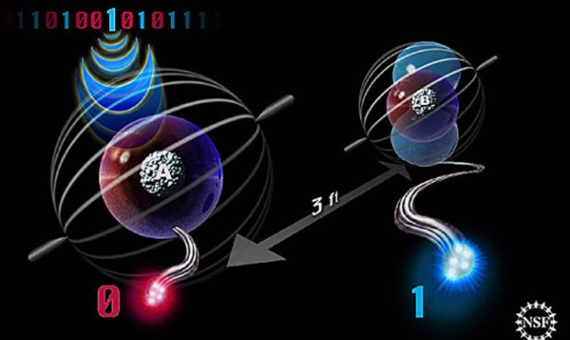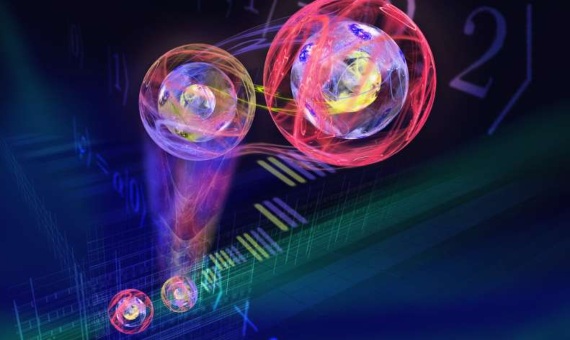In 2005, the obituary of physicist Asher Peres in the magazine Physics Today told us that when a journalist asked him if quantum teleportation could transport a person’s soul as well as their body, the scientist replied: “No, not the body, just the soul.” More than just a simple joke, Peres’ response offers a perfect explanation, encoded in a metaphor, of the reality of a process that we have seen countless times in science fiction. In fact, teleportation does exist, although in the real world it is quite different from the famous “Beam me up, Scotty!” associated with the Star Trek series.
Teleportation in real science began to take shape in 1993 thanks to a theoretical study published by Peres and five other researchers in Physical Review Letters, which laid the foundation for quantum teleportation. Apparently, it was co-author Charles Bennett’s idea to associate the proposed phenomenon with the popular idea of teleportation, but there is an essential difference between fiction and reality: in the latter it’s not matter that travels, but rather information, which transfers properties from the original matter to that of the destination matter.
Quantum teleportation is based on a hypothesis described in 1935 by physicist Albert Einstein and his colleagues Boris Podolsky and Nathan Rosen, known as the EPR paradox. As a consequence of the laws of quantum physics, it was possible to obtain two particles and separate them in space so that they would continue to share their properties, as two halves of a whole. Thus, an action on one of them (on A, or Alice, according to the nomenclature used) would instantaneously have an effect on the other (on B, or Bob). This “spooky action at a distance”, in Einstein’s words, would seem capable of violating the limit of the speed of light.

The theory of this phenomenon, called quantum entanglement, was later developed in 1964 by John Stewart Bell, and has been corroborated by numerous experiments. The work of Peres, Bennett and their collaborators proposed that a third particle could interact with Alice’s and lose a quantum state —the value of one of its physical properties— to be transferred to that of Bob, so that it would acquire that state. Without a transfer of matter, the Bob particle would be converted into a copy of the Alice interactive particle, and there would never have been physical contact between them.
Teleported qubits
Since 1998, various experiments have achieved this quantum teleportation, initially using individual photons, then atoms and more complex systems. At first the phenomenon was demonstrated at a short distance, which increased in subsequent studies to hundreds of metres and kilometres. The current record is the teleportation of photons 1,400 kilometres from Earth to the Micius satellite in Earth orbit, an achievement successfully carried out in 2017 by the team led by Jian-Wei Pan at China’s University of Science and Technology in Hefei (USTC).
In these experiments, what is transmitted is information coded in bits. In the classical sense, a bit is a basic unit of binary information that takes the value of 0 or 1. In its application to quantum states, a bit may contain information about, for example, the spin of a particle (a kind of rotation). But in the quantum version of the bit, the qubit, its value can be both 0 and 1 or another value, such as 2, since quantum mechanics allows states to overlap. This is why quantum computing is seen as a more powerful technology than traditional computing, since its capacity to store and process information is much greater.
However, it is essential to stress that quantum teleportation does not serve to transmit data instantaneously, or at faster than light speed. The reason is that Bob needs to get additional information about Alice’s measurements that is not transmitted through the entangled particle system, and therefore must be sent through another channel; for each teleported qubit two classic bits must be transmitted, and this can only be done through traditional ways that, at most, only reach the speed of light.
A future quantum network
But despite this limitation, the possibilities of quantum teleportation look more and more promising as new milestones are reached. This year, two teams of researchers have reported for the first time the transmission of qutrits, or three-dimensional units of information (which can take three values, 0, 1 and 2). “Both studies have demonstrated the teleportation of qutrit. The main difference is the method we used,” explains Bi-Heng Liu, physicist at UCTC and co-author of one of the as-yet-unpublished studies, to OpenMind.

However, at the moment there is still some controversy at play between the two teams. As explained to OpenMind by physicist Chao-Yang Lu, also from UCTC and co-author of the other study, published in Physical Review Letters, with regard to the work of his colleagues, “the very quantum nature of teleportation hasn’t been demonstrated.” Co-author of the same study Manuel Erhard, from the University of Vienna, also believes that in Liu’s experiment, “the measurements and results are not sufficient to claim genuine three-dimensional and universal quantum teleportation.” For his part, Liu defends his results: “We have done the numerical simulation and confirmed the teleportation of qutrits.”
The controversy also extends to the possibilities of scaling the system to a greater number of dimensions. According to Liu, “both schemes are scalable.” For his part, Erhard argues that his own system can easily be extended to any dimension: “It is a question of technological development to further increase the dimensionality,” he says. On the other hand, he’s not sure if the same can be said about his colleagues’ system.
But what is the point of expanding these experiments into a larger number of dimensions? “A possible application of high-dimensional quantum teleportation lies in quantum networks,” Erhard explains to OpenMind. “Thus, we envision a future quantum network that is based on higher-dimensional alphabets. These come with the advantage of higher information capacities and also larger resistance to noise, for example.”
Therefore, moving from qubit to qutrit, and from there to ququart, and so on, is now laying the foundation for future quantum computing networks. Lu predicts that his system will achieve so-called quantum supremacy, the ability to solve problems unattainable by classical computing: “We are implementing multi-photon multi-dimensional quantum computing experiments called boson sampling, and hopefully in the near future we hope to control 30-50 photons to reach quantum supremacy.”
Comments on this publication